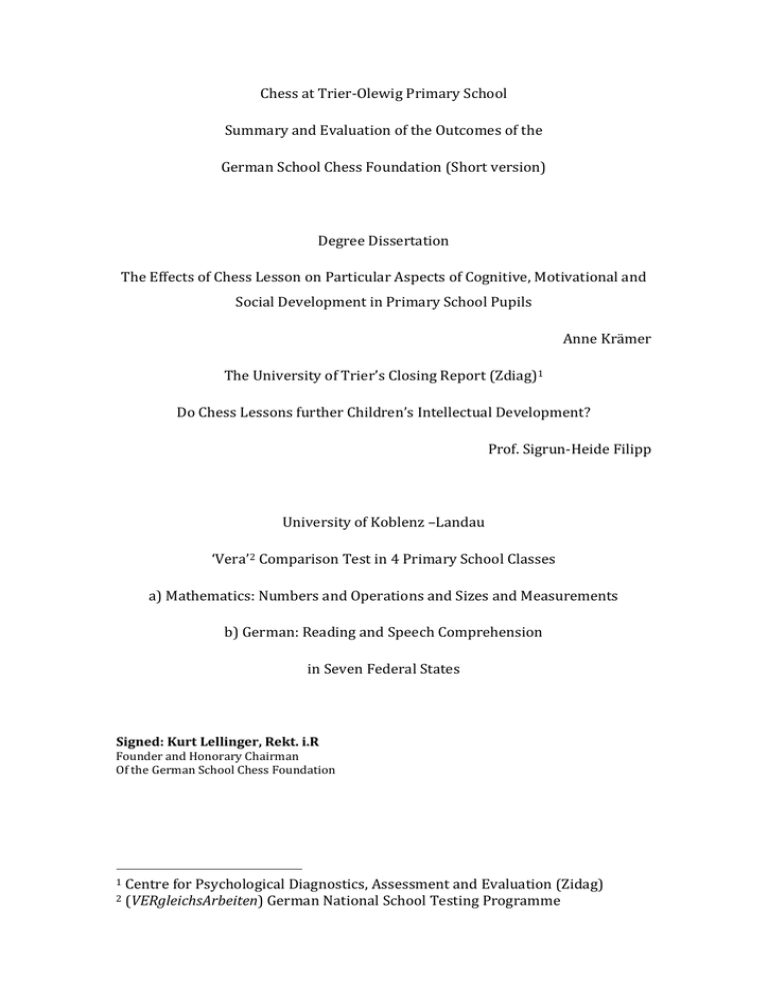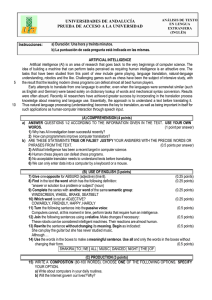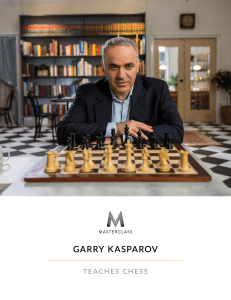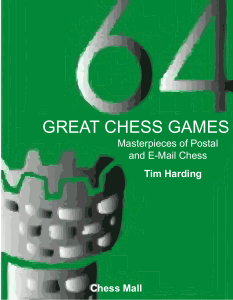Chess at Trier-Olewig Primary School
Anuncio

Chess at Trier-Olewig Primary School Summary and Evaluation of the Outcomes of the German School Chess Foundation (Short version) Degree Dissertation The Effects of Chess Lesson on Particular Aspects of Cognitive, Motivational and Social Development in Primary School Pupils Anne Krämer The University of Trier’s Closing Report (Zdiag)1 Do Chess Lessons further Children’s Intellectual Development? Prof. Sigrun-Heide Filipp University of Koblenz –Landau ‘Vera’2 Comparison Test in 4 Primary School Classes a) Mathematics: Numbers and Operations and Sizes and Measurements b) German: Reading and Speech Comprehension in Seven Federal States Signed: Kurt Lellinger, Rekt. i.R Founder and Honorary Chairman Of the German School Chess Foundation 1 2 Centre for Psychological Diagnostics, Assessment and Evaluation (Zidag) (VERgleichsArbeiten) German National School Testing Programme 01. The Pisa-Shock When in 2003 the ‘Pisa-shock’ heavily shook the German nation – the OECD’s study blatantly exposed Germany’s student’s performance in school to be at the bottom of the scale. The [German] Ministry of Education’s response was many directives. Quality improvement programs in lessons and schools were intended to usher in improvements. The weaknesses that needed to be bettered were well known: deficiencies in the learning behaviour of pupils, weaknesses in concentration and quality of speech, increased impulsiveness, aggression and hyperactivity, and also behavioural problems or problems in the acquisition of literacy and numeracy skills, such as reading, calculating and writing. 02. The Trier Study As part of the quality programs introduced in schools in the Rhineland-Palatinate region the primary school Trier-Olewig, working in conjunction with the German School Chess Foundation, incorporated a one hour chess lesson into the weekly timetable. The chess class was taken by all four school years and an hour of maths was ‘sacrificed’ for the chess lesson. The ‘Centre for Psychological Diagnostics, Assessment and Evaluation (Zidag)’ at the University of Trier undertook the task of testing to what extent the chess classes had positive effects on the development (in particular cognitive) of pupils. Simultaneously a school that did not provide chess classes, but had similar characteristics (social-economic background of pupils, class size amongst others) was the ‘test’ school (Olewig, School) and was also monitored as part of the study. Research Topics/Areas: 1. Concentration 2. Intelligence 3. Spelling skills 4. Inclusion (i.e. integration of mixed abilities/disabled pupils) The evaluation produced very complex results. Each result depends heavily on ability, which class and on when the research was collected. Furthermore this investigation was a field study and therefore not a laboratory experiment undertaken under strict conditions, which naturally resulted in a number of variables. Uncontrollable variables, such as the members of the class leaving as well as two changes in teachers, obviously had an effect on the results. It should also be noted that the period of time over which the test was conducted was a factor and the increase in age of pupils during the test played a role. As all classes began the chess classes at the same time the forth [and final] year could only be evaluated for one year, where as the first year pupils participated in 3.5 to 4 years of chess lessons. Summary of Results: a) Pupils in the test school demonstrated a significant improvement in perception and concentration. These results were most visible in first and second years and in the under-achieving pupils. b) A significant increase in intelligence was evident in second year children attending the test school. (Diagram on pages 9 to 11) c) Changes in spelling skills were not yet evident* * Spelling improvements were monitored. A New York study of 12 year olds demonstrated that chess lessons undertaken whilst children were learning to write did not necessarily aid their development of spelling skills. d) Notably higher levels of achievement motivation and social competencies were evident in year 3 and 4 pupils. e) ‘Phenomenal results’ in the 2006 Vera-Test (VERgleichsArbeiten)[national school testing programme in Germany] were recorded in the test school. Especially in German reading and speech comprehension, as well as mathematics: figures, operations and sizes and measurements. (Comparative tables pages 15-18). 03. Status of Research and the Assessment of the Trier Results The purpose of German School Chess Foundation’s investigation into the intellectual development of primary school children was less concerned with specified subjects (i.e. Maths/science and chess), than previous studies have been. Instead it focused on the acquisition of numeracy and literacy through the development of spatial- systematic- and principled thinking. For this reason the lessons were conducted according to the guidelines and the methodology of the German Chess Juniors’ (Deutsche Schach Jugend) ‘School Chess Patent’. Chess lessons followed the principles of Harmut von Hentig’s ‘Laboratory School’ that include methods such as ‘learning with all senses’ and ‘learning by doing’. From the beginning it was clear to the German School Chess Foundation (DSS) that ‘measurable results’ can only be expected after three to four years of regular chess lessons, as the results of the Vera Tests (VERgleichsArbeiten) [national school testing programme in Germany] distinctly prove. In this four year trial of the school chess project it was beneficial that the Trier University study did not focus on specified subjects (i.e. Maths/science and chess), as many other studies found in the literature on psychology have. They instead used a broader approach that considered the overall effect of the programme on intellectual ability and performance as well as elements of school integration and achievement motivation. A review of the specialist literature found studies which concentrated on the testing of cognitive/memory performance in chess-related subjects against nonchess related subjects. Such studies that focus on the results of chess and a specified subject, like chess and maths or chess and the sciences, do not focus on the broader aspects of thought and personality development that are so important for primary school children. This is where the Trier study is treading on new ground. 04. Further Proposals 1. The German School Chess Foundation in cooperation with University of Tier would like to continue supporting the extremely beneficial results observed so far. In addition the succeeding classes who will have received at least three to four years of chess lessons will continue to be studied. The results of the next set of Vera Tests will also be of great interest. 2. As the trial demonstrated that chess lessons evidently had a beneficial influence on under-achieving students, a long term trial should be undertaken at a special-needs school for children with learning difficulties. Both proposals depend on research being supported and made possible by the financial support of a backer (sponsor or patron). An behalf of the German School Chess Foundation Signed: Kurt Lellinger 4.1.2. Findings for the First Year – Concentration Ability Table 4.1.2: Averages, standard deviation and range of raw data values in thinking and concentration skills at both schools in all three test points (theoretical rang: 0-98). School Test Number Olewig (TG) Egbert (CG) Average Standard Deviation Minimum Value Maximum Value 1 50.98 15.66 20 70 2 61.15 17.86 26 84 3 87.04 17.76 28 98 1 50.78 18.35 21 85 2 70.05 22.62 31 98 3 76.38 20.57 37 98 (Key: TG = Test Group Olewig School. CG = Control Group Egbert School) The pupils who had chess lessons (Olewig School) demonstrated a substantial increase in the ability to concentrate between the second and third test dates. Where as the results of the pupils who did not receive chess lessons (Egbert) remained unchanged in the same time period. At the time of the third test the concentration capacity of the pupils who had received chess lessons was higher than those who had not (small but significant). School Year 1 – Under-achieving Students compared to High-achieving Students Figure 4.1.2.1: Thinking and concentration skills data of first year pupils over three test periods broken down by low- and high-achieving pupils. (Key: TG = Test Group Olewig School. CG = Control Group Egbert School) The difference between the results of both schools on the second test date was only statistically significant amongst the high-achieving students. The lowachieving students at both schools had similar results. In the third test the concentration skills of the low-achievers in the test group (Olewig) improved, to the extent that their test results were significantly higher than those of control group (Egbert). During the period between the second and third tests the concentration skills of the test group’s high-achieving pupils had managed to make up the difference and catch up with the control group. 4.2.3 Findings for the Second School Year – Intelligence Levels Table 4.2.3 Averages, standard deviance and value ranges at both schools at the time of all three tests (theoretical range: 0 to 60) School Olewig (TG) Egbert (CG) Test Average Standard Deviation Minimum Value Maximum Value 1 45.38 4.43 37 53 2 49.67 4.9 42 59 3 53.05 3.9 44 59 1 42.8 7.21 22 57 2 46.25 5.39 36 57 3 48.9 6.19 36 59 Figure 4.2.3 Absolute raw values Class 2 across all three test periods (theoretical range: 0 to 60) (Key: TG = Test Group Olewig School. CG = Control Group Egbert School) Similarly to the first year pupil’s results the date of the test was a significant deciding factor. That is the pupils of the second year also improved their performance across the whole period under study. There were no considerable differences between both groups’ results in the first test (t1). However, in the second (t2) and third (t3) tests the test group’s results (Olewig) were significantly higher than those of the control group (Egbert), which accounted for the larger overall improvement in the test group. Second School Year – Under-achieving Students compared to High-achieving Students Figure 4.2.3.1: Raw data in CFT1, Class 3 across/over three test periods (theoretical range 0 to 60), broken down by lowand high-achieving pupils. (Key: TG = Test Group Olewig School. CG = Control Group Egbert School) When results are broken down according to under-achieving students and highachieving students, low-achieving pupils from the test group (Olewig) performed better at the third test than the low-achieving pupils from the control group (Egbert). In terms of the high-achieving students there was no difference in the performance levels. 4.4.4 Results for the Third Year – Integration Table 4.4.4 – Averages, Standard Deviation and Value Range (theoretical Range: 15 to 60) School Integration Olewig (TG) Social 45.44 7.64 22 56 Emotional 39.28 7.63 17 52 Motivation 48 4.8 41 58 Social 45.45 8.76 24 59 Emotional 42.75 11.99 21 60 Motivation 42.9 7.15 24 55 Egbert (CG) Average Standard Deviation Minimum Value Maximum Value Figure 4.4.4: Scores for social, emotional and motivational integration (theoretical range: 15 to 60) (Key: TG = Test Group Olewig School. CG = Control Group Egbert School.) Based solely on ‘performance motivational integration’ there was a significant difference between both groups, the test group (Olewig) achieved higher results. 4.4.5 Results for the fourth year – Integration Table 4.4.5: Average, standard deviation and value range (theoretical range 15 to 60) School Olewig (TG) Egbert (CG) Integration Average Standard Deviation Minimum Value Maximum Value Social 49.57 8.6 29 59 Emotional 43.04 9.59 23 58 Motivation 45.09 6.14 33 57 Social 43.26 8.98 15 59 Emotional 36.89 11.32 16 53 Motivation 47.84 5.3 36 55 Figure 4.4.5: Scores for social, emotional and motivational integration (theoretical range: 15 to 60) (Key: TG = Test Group Olewig School. CG = Control Group Egbert School.) There were considerable difference between both groups in terms of ‘social-’ and ‘emotional integration’. The results of the test group (Olewig) were significantly higher than the control group (Egbert) respectively. School Chess Study Trier Conclusions: An obvious result was: regular chess games and chess lessons help pupils’ development. Provides evidence that the introduction of a regular school chess lesson is useful Chess has proved to be successful part of the quality improvement program aimed at overcoming the PISA –Shock in primary school. The Advantages of Chess for Youth In the following section you will find a summary of studies, facts and narratives on the positive effects of chess playing -both mentally and socially - on young people that I have collected over the last year. Studies According to a Texan study of academic abilities, ‘normal’ (meaning not gifted) pupils in elementary school, who took part in a school chess club progressed twice as quickly in maths and reading as children who did not play chess. A study undertaken in New Brunswick Canada split 437 year 5 (primary) pupils into 3 groups. Those who had some mathematics lesson supplemented with chess games showed an increased understanding and ability to solve mathematical problems. These improvement raised in proportion to the amount of chess time in their timetable. Dr Albert Frank conducted a study of 92 pupils aged between 16 and 18 years old. The chess-playing test group, when compared to the non-chess playing control group, demonstrated significant improvements in the areas of visual thinking, number sense, organisational and administrative skills as well as distinctly improved language abilities. The improvements were achieved independently of their prior level of knowledge. In a Belgian study of year 5 pupils, who played chess, a statistically significant improvement in cognitive abilities was observed. This was measured with the Piaget Test of cognitive development and compared to a control group. Perhaps what is even more noteworthy is these pupils achieved significantly better results in school-based assessments. They also received better results in tests conducted by an external agency, who were not aware of how the groups were split [chess-playing or non-chess playing pupils]. This is a quote by Dr. Adriaan de Groot: ‘Additionally the Belgian study demonstrates that engagement with these foundational, definitive and meaningful themes have a positive effect on motivation and the educational performance generally…!” In 4 year American study, which could be considered not statistically sound due to the small number of participants (15 students), the chess-playing students consistently performed better than the control group. These results were achieved despite the control group being involved in another programme geared to improve intellectual development at the same time. The parallel programme followed the basic criteria of the Watson-Glaser Critical Thinking Test and the Torrance Tests of Creative Thinking. The Venezuelan project ‘Learning to Think’, in which 10,000 teachers received training on the development of thinking skills and 4,266 2nd-year pupils took part, come to a general conclusion that chess was beneficial. Chess, when taught methodologically and using an incentive scheme, will notably accelerate the growth of IQ in primary school age children (in both sexes and regardless of socio-economic class) . Another study, based on a proportion of the New York City School Chess Programme, demonstrated that those who played chess significantly improved their reading ability. In a comparable study, that spanned 2 years in 5 American cities, two classes were picked in each of the 5 schools that took part. The group that received chess and logic lessons performed markedly better in reading than the control group, despite the control group receiving additional basic skills (reading, maths, social) classes. Facts Chess is considered to be an essential part of the timetable in nearly 30 countries. In Vancouver Math and Chess Learning Center has developed multiple text books that use the connection between chess and mathematical skills to support (Canadian) pupils in the learning of mathematics. The mathematics syllabus in New Brunswick Canada consists of a series of texts called ‘Mathematical Challenges’, in which pupils in classes 2 to 7 are taught logic through chess. After following this syllabus students’ average scores in problem solving increased from 63% to 81% in the province. In Quebec, where the program was first introduced, the best school mathematics results in the whole of Canada were achieved; internationally Canada did better than the USA in mathematics tests! The former US Secretary for Education, Terrell Bell, encourages chess to be considered as a means of fostering the intellectual abilities of pre-school children and increasing their proficiency to reach higher education. In the Federal state of New Jersey a new bill has been introduced that recognizes chess as a subject in the primary school curriculum. The bill states ‘in countries where chess is offered on a broad basis in schools, children exhibit excellent skills in understanding complex concepts and as a result of this excel in mathematics and the sciences’. On behalf of the School Chess Foundation Signed Kurt Lellinger .



